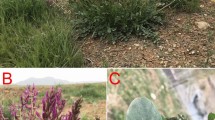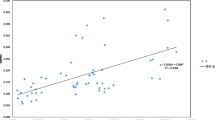Abstract
The genus Butia Becc. (Arecaceae) comprises 18 species distributed exclusively in South America, four of them in Uruguay: Butia lallemantii, B. paraguayensis, B. yatay and B. capitata. All species show serious regeneration problems which jeopardise their continuity in the near future. Butia lallemantii and B. paraguayensis are in the most critical situation, with restricted distributions (fragmented and reduced by cattle grazing and forestation) and populations with few individuals. Taxonomy in the genus is complex, and species delimitation remains unclear. The aim of this study was to examine the genetic variability of natural populations of B. paraguayensis, B. lallemantii and B. yatay, based on inter–simple sequence repeat markers, in view of long term conservation plans and to assist the taxonomic resolution of these closely related species. Twenty individuals from each population were sampled including four populations of B. lallemantii, three of B. yatay and the only B. paraguayensis population reported for Uruguay. Syagrus romanzoffiana was used as outgroup. Five primers were selected based on amplification profiles. Relationships among species were evaluated by constructing dendrograms and principal coordinates analysis. Genetic distance analyses indicate the existence of low variability among Butia species. Variability within populations was high, possibly due to gene flow, past hybridisation or life history traits. This variability provides great potential for recovery. Results do not allow us to suggest changes to the present taxonomic status of these species. We propose management recommendations involving restoration of recruitment and augmentation via stocks from within populations.




Similar content being viewed by others
References
Adin A, Weber JC, Sotelo Montes C, Vidaurre H, Vosman B, Smulders MJM (2004) Genetic differentiation and trade among populations of peach palm (Bactris gasipaes Kunth) in the Peruvian Amazon—implications for genetic resource management. Theor Appl Genet 108:1564–1573
Aguilar R, Quesada M, Ashworth L, Herrerias-Diego Y, Lobo J (2008) Genetic consequences of habitat fragmentation in plant populations: susceptible signals in plant traits and methodological approaches. Mol Ecol 17:5177–5188
Allendorf FW, Hohenlohe PA, Luikart G (2010) Genomics and the future of conservation genetics. Nat Rev Genet 11:697–709
Bohonak AJ (1999) Dispersal, gene flow, and population structure. Q Rev Biol 74(1):21–46
Borchsenius F (1997) Flowering biology of Geonoma irena and Geonoma cuneata var. sodiroi (Arecaceae). Pl Sys Evol 208:187–196
Brito A, Nebel JP (1998) Relicto de Butia paraguayensis en Rivera. Uruguay Forestal 8(19):21–23
Brussa CA, Grela IA (2007) Flora Arbórea del Uruguay. Con énfasis en las especies de Rivera y Tacuarembó. COFUSA, Uruguay
Cabrera-Toledo D, González-Astorga J, Vovides AP (2008) Heterozygote excess in ancient populations of the critically endangered Dioon caputoi (Zamiaceae, Cycadales) from central Mexico. Bot J Linn Soc 158:436–447
Cardoso SRS, Eloy NB, Provan J, Cardoso MA, Ferreira PCG (2000) Genetic differentiation of Euterpe edulis Mart. populations estimated by AFLP analysis. Mol Ecol 9:1753–1760
Clewell A, Rieger J, Munro J (2005) Guidelines for developing and managing ecological restoration projects, 2nd ed. Society for Ecological Restoration International, Tucson
Deble LP, Marchiori JNC (2006) Butia lallemantii, uma nova Arecaceae do Brasil. Balduinia 9:1–3
Doyle JJ, Doyle JL (1987) A rapid DNA isolation procedure for small quantities of fresh leaf tissue. Phytochemistry 19:11–15
Excoffier L, Smouse PE, Quattro JM (1992) Analysis of molecular variance inferred from metric distances among DNA haplotypes: application to human mitochondrial DNA restriction data. Genetics 131:479–491
Falush D, Stephens M, Pritchard JK (2007) Inference of population structure using multilocus genotype data: dominant markers and null alleles. Mol Ecol Notes 7:574–578
Feyissa T, Nybom H, Bartish IV, Welander M (2007) Analysis of genetic diversity in the endangered tropical tree species Hagenia abyssinica using ISSR markers. Genet Resour Crop Evol 54:947–958
Frankham R, Ballou JD, Briscoe DA (2002) Introduction to conservation genetics. Cambridge University Press, Cambridge
Gaiero P, Mazzella C, Vaio M, Lopez-Carro B, Santiñaque F, Folle G (2008) Citogenética y Contenido de ADN en las especies nativas de palmas (Arecaceae). I Jornadas de la Sociedad Uruguaya de Genética, Montevideo
Glassman SF (1979) Re-evaluation of the genus Butia with a description of a new species. Principes 23(2):65–70
Hamrick JL, Godt MJW (1996) Effects of life history traits on genetic diversity in plant species. Phil Trans R Soc Lond 351:1291–1298
Heiden G (2010) Diversidade e distribuiçâo geográfica de Butia (Arecaceae). V Simpósio do Morango. IV. Encontro sobre Pequenas frutas e Frutas nativas do MERCOSUL, Pelotas, Brazil
Hubisz M, Falush D, Stephens M, Pritchard JK (2009) Inferring weak population structure with the assistance of sample group information. Mol Ecol Resour 9:1322–1332
Hunter PR, Gaston MA (1988) Numerical index of the discriminatory ability of typing systems: an application of Simpson’s index of diversity. J Clin Microbiol 26:2465–2466
Jaccard P (1908) Nouvelles recherches sur la distribution florale. Bull Soc Vaudoise Sci Nat 44:223–270
Jones DL (1995) Palms throughout the world. Smithsonian Institution Press, Washington DC
Kapelan Bio-Imaging (1999–2003) Lab image, free edition. Version 2.7.0
Klatt BJ, Niemann RS (1996) Use of corporate lands. In: Falk DA, Millar CI, Olwell M (eds) Restoring diversity: strategies for reintroduction of endangered plants, 1st ed. Island Press, Washington DC, pp 343–362
Lexer C, Kremer A, Petit RJ (2006) Shared alleles in sympatric oaks: recurrent gene flow is a more parsimonious explanation than ancestral polymorphism. Mol Ecol 15(7):2007–2012
Lowe AJ, Boshier D, Ward M, Bacles CFE, Navarro C (2005) Genetic resource impacts of habitat loss and degradation; reconciling empirical evidence and predicted theory for neotropical trees. Heredity 95:255–273
Mantel N (1967) The detection of disease clustering and a generalized regression approach. Cancer Res 27:209–220
Marcato AM (2004) Revisão taxonômica do gênero Butia (Becc.) Becc. e filogenia da subtribo Butiinae Saakov (Palmae). PhD Dissertation, Instituto de Biociencias da Universidade de São Paulo, Brazil
Marchiori JNC (2004) Fitogeografia do Rio Grande do Sul: campos sulinos. EST, Porto Alegre, Brazil
Masat O, Olga M, Chatellenaz ML, Fontana JL (2008) Dispersión de Butia yatay (Arecaceae) por el Ñandú (Rhea americana) en el Parque Nacional Mburucuyá, Corrientes. XII Reunión Argentina de Ornitología. San Martín de los Andes, Neuquén
Mayes SG, Mcginley MA, Werth CR (1998) Clonal population structure and genetic variation in sand-shinnery oak, Quercus havardii (Fagaceae). Am J Bot 85(11):1609–1617
Meerow AW, Noblick L, Borrone JW, Couvreur TLP, Mauro-Herrera M, William J, Hahn WJ, Kuhn DN, Nakamura K, Oleas NH, Schnell RJ (2009) Phylogenetic analysis of seven WRKY genes across the palm subtribe Attaleinae (Arecaceae) identifies Syagrus as sister group of the coconut. PLoS ONE 4(10):e7353
Morel M (2006) Morfología floral y fenología de la floración de la palma Butia capitata (Mart.) Becc. Arececeae. Graduate Dissertation, Facultad de Ciencias, Universidad de la República, Uruguay
Moritz C (1994) Defining ‘evolutionarily significant units’ for conservation. Trends Ecol Evol 9(10):373–375
Mourelle D, Gaiero P, Speroni G, Beri A, Mazzella C (2010) Variaciones en la morfología polínica de Butia lallemantii, Butia paraguayensis y Butia yatay, palmas (Arecaceae) nativas de Uruguay. X Congreso Latinoamericano de Botánica, La Serena
Muir G, Schlötterer C (2004) Evidence for shared ancestral polymorphism rather than recurrent gene flow at microsatellite loci differentiating two hybridizing oaks (Quercus spp.). Mol Ecol 14(2):549–561
Nei M, Li WH (1979) Mathematical model for studying genetic variation in terms of restriction endonucleases. Proc Natl Acad Sci USA 76:5269–5273
Noblick LR (2010) Butia. In: Lorenzi H, Noblick LR, Kahn F, Ferreira E (eds) Flora brasileira Lorenzi: Arecaceae (palmeiras). Instituto Plantarum, Nova Odessa, Brazil
Nunes AM, Bianchi VJ, Fachinello JC, De Carvalho AZ, Cardoso G (2008) Caracterização Molecular de Butiazeiro por Marcadores RAPD. Rev Bras Frutic 30(3):702–707
Paroul N, Cansian RL, Rossato M, Pauletti GF, Serafini LA, Rota L, Moyna P, Heinzen H (2009) Use of Palmae wax hydrocarbon fractions as chemotaxonomical markers in Butia and Syagrus. Braz J. Biol 69(2):353–361
Peakall R, Smouse PE (2006) GENALEX 6: Genetic Analysis in Excel. Population genetic software for teaching and research. Mol Ecol Notes 6:288–295
Pintaud JC, Galeano G, Balslev H, Bernal R, Borchsenius F, Ferreira E, de Granville JJ, Mejía K, Millán B, Moraes M, Noblick L, Stauffer FW, Kahn F (2008) Las palmeras de América del Sur: diversidad, distribución e historia evolutiva. Rev Peru Biol 15(1):7–29
Primack RB (1996) Lessons from ecological theory: dispersal, establishment, and population structure. In: Falk DA, Millar CI, Olwell M (eds) Restoring diversity: strategies for reintroduction of endangered plants, 1st ed. Island Press, Washington DC, pp 209–233
Pritchard JK, Stephens M, Donnelly P (2000) Inference of population structure using multilocus genotype data. Genetics 155:945–959
Rivas M, Barilani A (2004) Diversidad, potencial productivo y reproductivo de los palmares Butia capitata (Mart) Becc. de Uruguay. Agrociencia VIII(1):11–20
Rodríguez-Mazzini R, Molina B (1990) El zorro de monte (Cerdocyon thous) como agente dispersor de semillas de palma. Documentos de Trabajo 30. PROBIDES, Rocha, Uruguay
Roncal J, Francisco-Ortega J, Lewis CE (2007) An evaluation of the taxonomic distinctness of two Geonoma macrostachys (Arecaceae) varieties based on intersimple sequence repeat (ISSR) variation. Bot J Linn Soc 153:381–392
Rosa L, Castellani TT, Reis A (1998) Biologia reprodutiva de Butia capitata (Martius) Beccari var. odorata (Palmae) na restinga do município de Laguna, SC. Rev Bras Bot 21(3):281–287
Rossato M (2007) Recursos genéticos de butiás do Rio Grande do Sul. PhD Dissertation, Universidade Federal de Pelotas, Brazil
Rossato M, Barbieri RL, Schafer A, Zacaría J (2007) Caracterizaçao molecular de populaçoes de palmeiras do gênero Butia do Rio Grande do Sul através de marcadores ISSR. Magistra 19(4):311–318
San Martín H, Prigioni C, Sappa A, San Martín A (1996) Informe preliminar sobre algunos grupos zoológicos vinculados al ciclo anual de la palma butiá Butia capitata (Mart.) Becc. Acta Zool Platense 1(2):1–15
Schlüter PM, Harris SA (2006) Analysis of multilocus fingerprinting data sets containing missing data. Molec Ecol Notes 6:569–572
Slatkin M (1987) Gene flow and the geographic structure of natural populations. Science 236(4803):787–792
Sreekumar VB, Renuka C (2006) Assessment of genetic diversity in Calamus thwaitesii Becc. (Arecaceae) using RAPD markers. Biochem Sys Ecol 34:397–405
Svenning JC (2001) On the role of microenvironmental heterogeneity in the ecology and diversification of neotropical rain-forest palms (Arecaceae). Bot Rev 67(1):2–41
Thornton HE, Roncal J, Lewis CE, Maschinski J, Francisco-Ortega J (2008) Conservation genetics of Jacquemontia reclinata (Convolvulaceae), an endangered species from southern Florida: implications for restoration management. Biotropica 40(4):507–514
Uhl NW, Dransfield J (1987) Genera Palmarum, a classification of palms based on the work of Harold E. Moore Jr. The L.H. Bailey Hortorium and the International Palm Society, Lawrence, KS
Ward M, Dick CW, Gribel R, Lowe AJ (2005) To self, or not to self. A review of outcrossing and pollen-mediated gene flow in neotropical trees. Heredity 95:246–254
Wright S (1951) The genetic structure of populations. Ann Eugen 15:323–354
Xifreda CC, Sanso AM (1996) Nueva combinación en Butia (Arecaceae). Hickenia 43(II):207–208
Zietkiewicz E, Rafalski A, Labuda D (1994) Genome fingerprinting by simple sequence repeat (SSR)-anchored polymerase chain reaction amplification. Genomics 20:176–183
Acknowledgments
This work was supported by a grant from Agencia Nacional de Investigación e Innovación (ANII) Fondo Clemente Estable (project ID FCE2007_612, Uruguay) and Universidade de Caxias do Sul (Brazil). Gaiero was supported by a post-graduate grant from Instituto Nacional de Investigación Agropecuaria (Uruguay), and her internship at Universidade de Caxias do Sul was financed by Comisión Sectorial Investigación Científica, Universidad de la República (CSIC-UdelaR, Uruguay). We wish to thank L. Noblick for plant identification, J. Zacaría for assistance in DNA extractions and P. Speranza, G. García and M. Rivas for useful comments on the manuscript and figures. We are thankful to anonymous reviewers for their invaluable suggestions and insights. We are grateful to COFUSA, FYMNSA and Weyerhaeuser for kindly allowing sample collection on their property and to their staff for assistance in the field.
Author information
Authors and Affiliations
Corresponding author
Rights and permissions
About this article
Cite this article
Gaiero, P., Mazzella, C., Agostini, G. et al. Genetic diversity among endangered Uruguayan populations of Butia Becc. species based on ISSR. Plant Syst Evol 292, 105–116 (2011). https://doi.org/10.1007/s00606-010-0412-0
Received:
Accepted:
Published:
Issue Date:
DOI: https://doi.org/10.1007/s00606-010-0412-0




